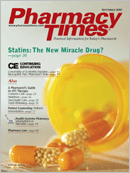Publication
Article
Pharmacy Times
Current Options for the Treatment of Warts
Author(s):
Warts are a type of infection causedby viruses in the human papillomavirus(HPV) family. More than 100 types ofHPV exist, and different categories causedifferent types of warts. Warts can growon any part of the body, including onthe skin, the inside of the mouth, thegenitals, or the rectal area. The infectionis typically contracted through directcontact, although secondary contact,such as with locker room floors or swimmingpools, is also a possible means oftransmission. Several options are availablefor treating warts, depending on thelocation and the type of infection.
Types of Warts
The 5 primary types of warts, eachwith distinct characteristics, are as follows:
•Common warts (verrucca vulgaris)are generally raised wartswith a rough surface, and areoften referred to as seed warts,because their appearance mayresemble that of a small seedstuck to the skin. While this typeof wart can occur anywhere, it ismost commonly found on thehands, particularly the knucklesand nail folds.
•Plantar warts (verruca vulgaris)are found on the soles of the feet,and are most often found underthe skin's surface as a result of thepressure caused by body weight.Plantar warts are usually hard andflat and may appear with a blackdot in the center, which is actuallythe wart's blood supply. Thesewarts may be painful and are oftenthe most difficult type to resolve.Plantar warts may occur in clusters,which are also known asmosaic warts.
•Plane warts (verruca plana) areusually round with flat tops andsmooth surfaces. These can occuranywhere on the body, but arecommon on the backs of thehands, the faces of children, andcommonly shaved areas, such aswomen's legs or men's faces.
•Filiform warts (verruca filiformis)are long, slender warts which aretypically found on thin-skinnedareas such as the eyelids, armpits,or neck area.
•Genital warts (condylomataacuminata) are a common problemamong sexually active adults, andcan be found in or around thevagina, around the anus, in therectum, as well as on the vulva,cervix, or penis. The appearance ofthese warts varies, as more than 30strains of HPV exist which caninfect the genital tract, but genitalwarts are typically soft and maydevelop a cauliflower-like appearanceand can appear alone or ingroups.
Treatment Options
The type of treatment depends onthe location, type, and number ofwarts. Options include the following:
OTC Medications
OTC medications typically containsalicylic acid as the active ingredient.This drug, which can be found as anointment or a topical solution, softensthe skin and causes the layers to peelaway, removing the wart with it.
Prescription Remedies—CommerciallyAvailable
- Condylox (podofilox)
- Penlac (ciclopirox)
Prescription Remedies—CompoundedPreparations
Prescription remedies often are preparedby a compounding pharmacist.With a compounded preparation,many combinations and dosage formsare possible, and there is a great deal offlexibility for the prescribing physician.Preparations include the following:
- Acyclovir ointment or suppositories
- Dinitrochlorobenzene solution
- Diphenylcyclopropenone topical solution
- Podophyllum solution, ointment, or gel
- Lactic acid and salicylic acid in flexible collodion
- Trichloroacetic acid topical solution
- Dibutyl squarate solution
- Salicylic acid gel
- 5-fluorouracil
- Cimetidine cream
- Deoxy-D-glucose (often used in combination with cimetidine)
- Cantharidin
Nonpharmacologic Options
•Cryotherapy involves the use ofliquid nitrogen, which is appliedto the surface, freezing the wart.This type of treatment is usuallycarried out in a clinician's officeand can be painful. Cryotherapymay need to be repeated for largeareas or clusters of warts.
•Surgical excision is the mostrapid means of treatment, but it ispainful and requires the use of alocal anesthetic. This treatment isparticularly useful for removinglarge warts.
•Laser treatment destroys thewart(s) by using a precise laserbeam and electrocautery. Discomfortfollowing this type oftreatment is common.
Ms. Fields is with the International Journalof Pharmaceutical Compounding and is apharmacy technician at Innovative PharmacySolutions in Edmond, Okla.







